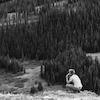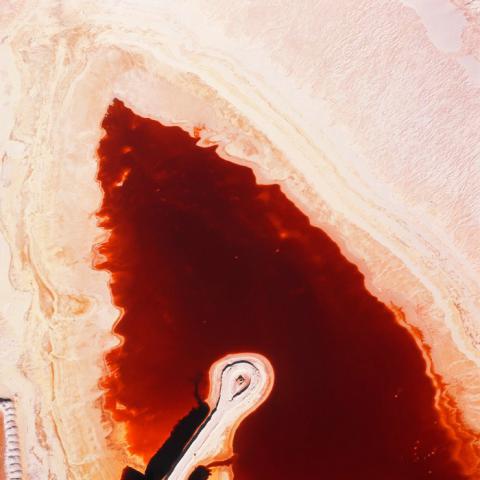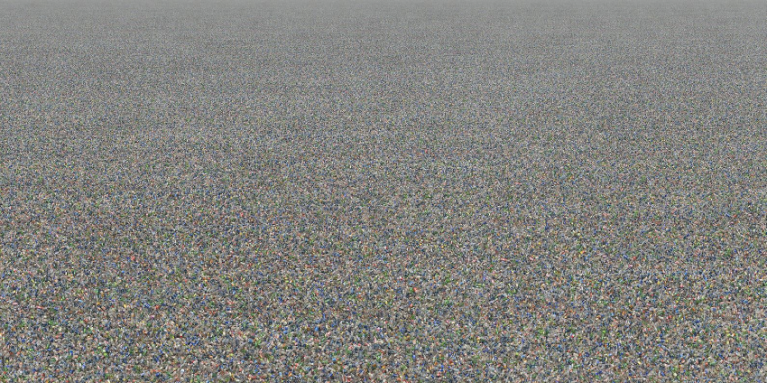February 9, 2015 - 23:55

In much of the art about our ecological reality, artists have brought attention to the terrible impacts humans have on the planet. Images of stump-littered fields from clear-cut forests, open pit sores from mining the earth, devastating oil spills, charred remains of human-caused forest fires sprout up all around us. These images are, to say the least, stunning. The systems thinking, the deep interconnectedness of all beings, or what Timothy Morton calls, “the ecological thought”,1 is particularly present in these projects. Used in this kind of art, the ecological thought is like swimming in a deep ocean: when confronted with the consequences of consumerist lifestyles, we must plunge below the surface to look at at the costs of our material comfort and how they affect the flora, fauna, and the planet we call home. But I am also curious about what such ecological art, particularly visual art, does after it makes us take that deep dive. Interrogaging our place in the world, one must ask: Can we change, or is this just the “new normal?” Can images move us to act, or are they “simply the bemused awareness, continually restocked by photographic information, that terrible things happen”?2
In order to get a sense of art's engagement in ecological thinking, let's first take a look David Maisel's powerful aerial photographs of American mines. The aerial perspective, far above the efforts of individual humans, is a vital tool for photographers like Maisel to capture the horrific instances of our footprint on the earth. By flying high above the earth's surface, Maisel's images show us our large-scale impact like we have never seen before. The images are hauntingly beautiful, in the same way that a fire consuming a house is captivating, even elegant. The toxic subjects Maisel photographs are also visually intoxicating.

David Maisel, The Mining Project (Inspiration, Arizona 10), 1989
While looking at the photographs, we are meant to feel empathy for the victim: Earth itself. Industrialism, Maisel shows, has no concept of what is sacred or what is enough. Yet simultaneously, the crime we are witnessing is one we take part in: the production of consumer goods demands more extraction using cheaper (and more harmful) methods. The discolored chemical stew lying in gouged wounds in the Earth—out of mind for consumers—makes the viewer wonder who is to blame.
Similar artists' work evokes a sense of injustice in the viewer. They offer a gaze in to the dark present of our consumerist society. They are a reminder that our use of technology, plastic, has ramifications on people and ecosystems in their journey into our hands and departure from them. However, only a look at the grotesque, the sites of our crime, does little in considering ways to address the more abstract root causes of consumerism and the accumulation of wealth, which is central to our narrow definitions of progress and the “good life.” The images seem so foreign, like a snapshot from another planet, that we may feel even more disconnected from Earth itself.
Working in similar themes, Chris Jordan's Running the Numbers takes everyday objects—cell phones, cigarettes, plastic water bottles, car keys, paper bags—to depict unimaginable statistics. In each piece, the viewer is shown both the collective accumulation of these objects or those they represent, as well as the individual objects themselves. One single plastic water bottle, a recognizable object, is merely a dot in a sea of its two million counterparts, all used in the USA within 15 minutes. As we zoom in, we are again confronted with horror: a massive collage of waste, created by an accumulation small contributions.

Chris Jordan, "Plastic Bottles", 2007
Jordan exhibits a creative way to locate ourselves in a larger picture. Yet still, even with recognizable everyday objects, their collective immensity is daunting. Individuals and environmental groups, even environmental studies and sciences programs,3 don't know where to begin or how to place individual efforts in a group framework. While Chris Jordan's art exposes vividly the size and shape of American consumerism, it is still up to the viewer to decide how to translate their terror into action—if at all.
Ecological art, or art intentionally engaged with ecological thinking, can create staggering representations of our current lifestyles and their lasting, often hidden effects. However, it also has potential for reimagining our ways of life, our modes of valuation, and our fundamental remaking of the world. Provocative images, like those by David Maisel, Chris Jordon, and others, are reminders of the work that still needs to be done, of the other narratives that need to be told. But the images themselves depict a frightening reality, one that we individuals contribute to and often feel helpless to address. It is often what is most visceral, most striking, most painful that grips our attention and memory the most. Are there ways of portraying the reality of our ecological crisis, engaging the public to think about their position, and encouraging a reshaping of our own contexts? Because of these many fundamental questions, I feel it is necessary that we begin to gather around these topics of representation and agency in the midst of ecological crisis. We, as stewards of this world, have to cultivate our imaginations to contemplate ways in which we can critically examine and reexamine social structures and norms that have brought us us here. The problems aren't just out there—they are deeply embedded in our own actions and assumptions. Yet we can—and must—engage them in our own contexts.
As a college student, I see the need for a communal space to engage deeply with questions surrounding environments, representation, experience, and change outside of traditional classroom settings. Indeed, the liberal arts college, built on academic reasoning and structures of privilege, may itself be counterproductive in facilitating conversations that question hegemonies, institutions, human nature, and the “self” at their cores. Using art as a central mode for engagement, I envision a group of people who both talk about and create art concerning ecological thinking; art that comes into contact with central questions regarding the future, fear, loss, struggle, hope, and empowerment. For now, let's call this fictional group the Ecological Art Community.
Welcoming to all, the community would be open to local college students, faculty members, and surrounding residents interested in thinking and making art through these broad ideas. Dialogue, a twofold reflection and action, requires “a profound love for the world and for people.”4 This dialogue structures the community as dually an informal reading group and collaborative creative space. The reading group would have one facilitator, who would first develop a rough curriculum consisting of artists' work and diverse readings working in the broad themes of consumerism, identity in and experiences of nature, climate change, dominant power structures, alternative ways of living, and social change. The curriculum would evolve with the interests of the group. Community members would use this knowledge to create public art projects together (beginning first on the college campus itself), which would develop from themes and discussions regarding the material they read.
Evidently, I've raised more questions than answered here. The curriculum remains in its fledgling stage. My knowledge is limited, and my explorations in the topic of ecological representation have only just begun. Timothy Mortonthat ecological thinking is melancholic, “intrinsically dark, mysterious, and open.”5 We need to plunge into the distressing, dark, terrifying, sickening images that show the many sides of our distorted relationship with our planet, other organisms, and people. But we also desperately need to return to the surface and make something with those experiences. It means that we have to go beyond mourning an already sick planet, beyond the paralysis of individual implication in ecological crimes, and become implicated in communal forms of radical hope.
Morton, Timothy. The Ecological Thought. Harvard: Harvard University,2012. Web. ↩
Sontag, Susan. Regarding the Pain of Others. New York: Farrar, Straus and Giroux, 2003. Print. ↩
Maniates, Michael. "Teaching for Turbulence." Is Sustainability Still Possible? Worldwatch Institute. p. 258. Web. ↩
Friere, Paulo. Pedagogy of the Oppressed. London: Penguin, 1996. p. 70. Print. ↩
Morton, Timothy. The Ecological Thought. Harvard:Harvard University, 2012. p. 16. Web. ↩

Comments
“staggering representations”
Submitted by Anne Dalke on February 15, 2015 - 01:02 Permalink
Caleb--
You offer two very striking images here, to illustrate and anchor your analysis. Thank you for these.
Pairing them leads me to ask, straight off, whether you think that the work of Maisel and Jordan differ, in the terms that you go on to describe: do Maisel’s images stop us in our tracks, while Jordan’s lead us on to the larger context (of, say, waste disposal)? Along these lines…have you noticed the Daily Overview that Abby called our attention to? The mission statement @ that site says, “The mesmerizing flatness seen from this vantage point, the surprising comfort of systematic organization on a massive scale, or the vibrant colors that we capture will hopefully turn your head. However, once we have that attention, we hope you will go beyond the aesthetics, contemplate just exactly what it is that you're seeing, and consider what that means for our planet.”
When you ask, “can images move us to act, or are they simply the bemused awareness, continually restocked by photographic information, that terrible things happen?”, I am put in mind of the binary Stephen Greenblatt worked between “wonder” and “resonance.” I’m re-reading (and re-stating) the conundrum you work here, in seeing the various “staggering representations” you highlight as evoking a negative version of “wonder”—stopping us in our tracks, as we are “confronted with horror,” by “foreign images” that we “don’t know how to place in a group framework.” And I see placing such experiences of “the grotesque, the sites of our crime,” in the context of “the more abstract root causes of consumerism and the accumulation of wealth” is a way of seeking what Greenblatt calls “resonance,” of exploring the larger world out of which these images emerge--and so finding ways (again, in your language) “to translate terror into action”: “portraying the reality of our ecological crisis, engaging the public to think about their position, and encouraging a reshaping of our own contexts.”
So: I like this analysis. And I very much appreciate your observation that “the liberal arts college, built on academic reasoning and structures of privilege, may itself be counterproductive in facilitating conversations that question hegemonies, institutions, human nature, and the ‘self’ at their cores” (in the language of the paragraph above, that colleges and the education they offer might resist the exploration of “resonance”?)
Where all this gets really challenging, of course, is in activating the movement from “wonder” to resonance,” from “horror” to “action,” from identifying hegemonies to re-structuring them. I’m drawn to your imagining of an “Ecological Art Community, an informal reading group and collaborative creative space” in which folks could “go beyond mourning and paralysis” to acknowledge our “implication in ecological crimes.” And/but: what do you imagine as the outcomes of such a community? Is it more art-making? Public art-making? Public action….?
P.S. Maddie & Caleb—you should check out one another’s projects, since they are both about making this work “stick.”